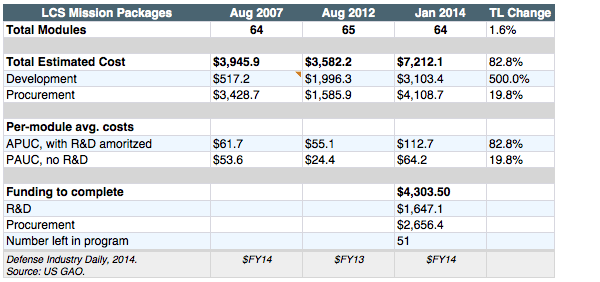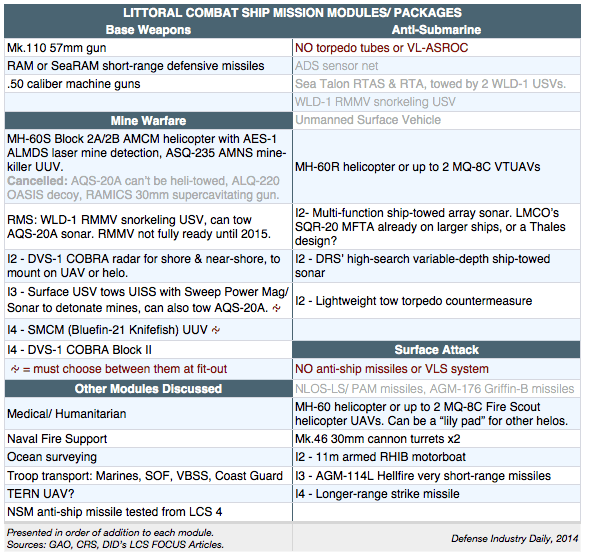At 115 – 127 meters in length and 2,800 – 3,100 tons of displacement, the USA’s competing LCS ship designs are almost the size of Britain’s Type 23 frigates. They might well be classified as frigates, were it not for their shallow water design and employment. For whatever reason, high speed has also been identified as an important ship characteristic. As such, both the GD/Austal trimaran and Lockheed’s racing-derived monohull offer potential top speeds of 40-50 knots over short distances.
No matter which mission modules are loaded, the ship will carry a BAE Systems Mk.110 57mm naval gun with a firing rate of up to 220 rounds/minute, and Mk.295 ammunition that works against aerial, surface or ground threats. The ship will also carry .50 caliber (12.7mm) machine guns, plus defensive systems including automated chaff/flare dispensers and a launcher for Raytheon’s RIM-116 RAMRolling Airframe Missile. RAM is designed to handle anti-ship missiles, aircraft, UAVs, helicopters, and even small boats, but its range of just 9 km/ 5 nm will only protect its own ship. Unlike larger missiles such as the RIM-162 ESSM, RAM systems cannot perform fleet defense.
LCS ships will also rely on their onboard MH-60 helicopters and/or MQ-8B Fire Scout helicopter UAVs, plus other robotic vehicles including a variety of Unmanned Underwater Vessels (UUV) and Unmanned Surface Vessels (USV). The terms have changed over time, but the US Navy has downgraded the term “mission modules” to mean individual components plus their support equipment. Integrated packages of weapons, sensors, robotic vehicles, and manned platforms that can be switched in and out depending on the ship’s mission are now called “mission packages.” They include all task-related mission modules, onboard aircraft, and their corresponding crew detachments.
The ships’ first and most important mission package is not officially listed. It consists of a small but very cross-trained crew. LCSs were intended to operate with a core crew of 40 (now 50) sailors, plus a mission module detachment of 15 and an aviation detachment of 25. Each ship has a Blue crew and a Gold crew, which will shift to 3 crews over time that can deploy in 4-month rotations.
There are concerns that this is a design weakness, leaving the LCS crew at the edge of its capabilities to just run the ship, with insufficient on-board maintenance capabilities, and too little left over for contingencies such as boarding and search, damage control, illnesses, etc. USS Freedom’s addition of 10 more bunks before her 1st Asian deployment indicates that the US Navy may be about to concede this point, but even with 50, performance wasn’t great.
Beyond the human element, the LCS program will initially draw upon packages for Mine Warfare (MCM: 24 planned), Anti-submarine Warfare (ASW: 16 planned) and Surface Warfare (SUW: 24 planned). The LCS Mission Modules Program Office (PMS 420) packages a variety of technologies to these ends, many of which are produced by other program offices and delivered as elements of a particular mission module. Costs per module have gone down over time, but that hasn’t been from any genius in planning and fielding. Rather, it results from a high program failure rate of individual components, and their replacement in the program by less expensive items:





